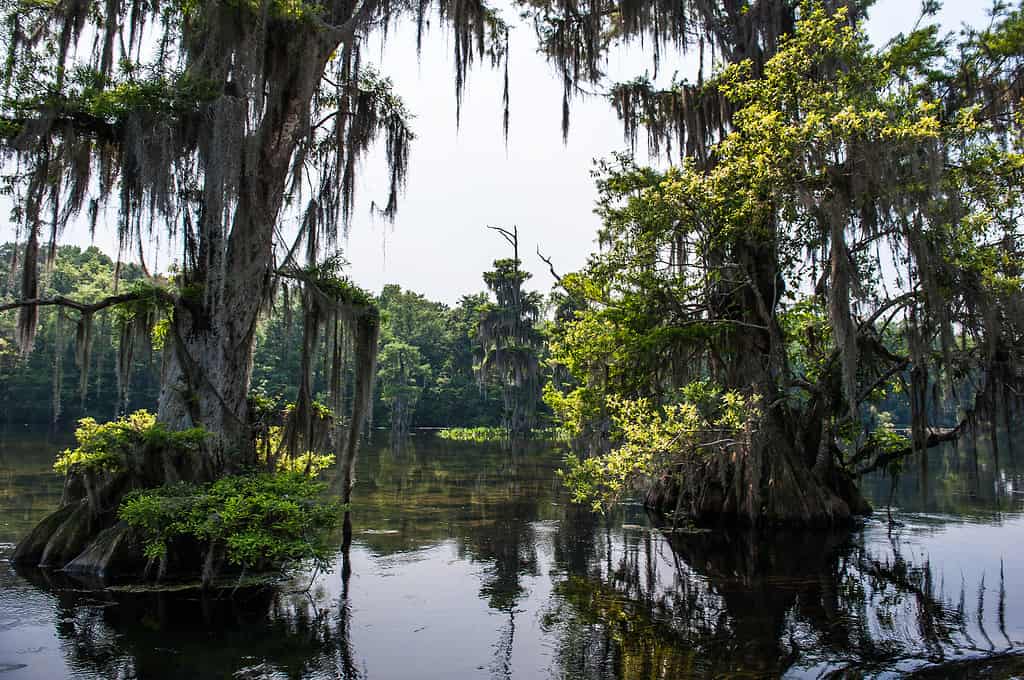
Florida’s diverse, humid climate is the perfect environment for snakes to thrive.
©Chongbum Thomas Park/Shutterstock.com
Spanning more than 65,000 square miles and with 1,350 miles of coastline, Florida has a vast landscape. Although known for its sunny climate, Florida is much more diverse than you might expect. There is a vast array of habitats – from rivers and swamps, to rainforests, to stunning coral reefs. All of these rich habitats are teeming with life – both large and small. However, one type of animal that Florida is best known for is its snakes. Florida is home to more than 50 native species, of which six are venomous. Snakes are known for their wonderful colors and patterns, and one of the brightest colors we’ll see is orange. So join us as we discover the orange snakes in Florida!

Eastern Rat Snake
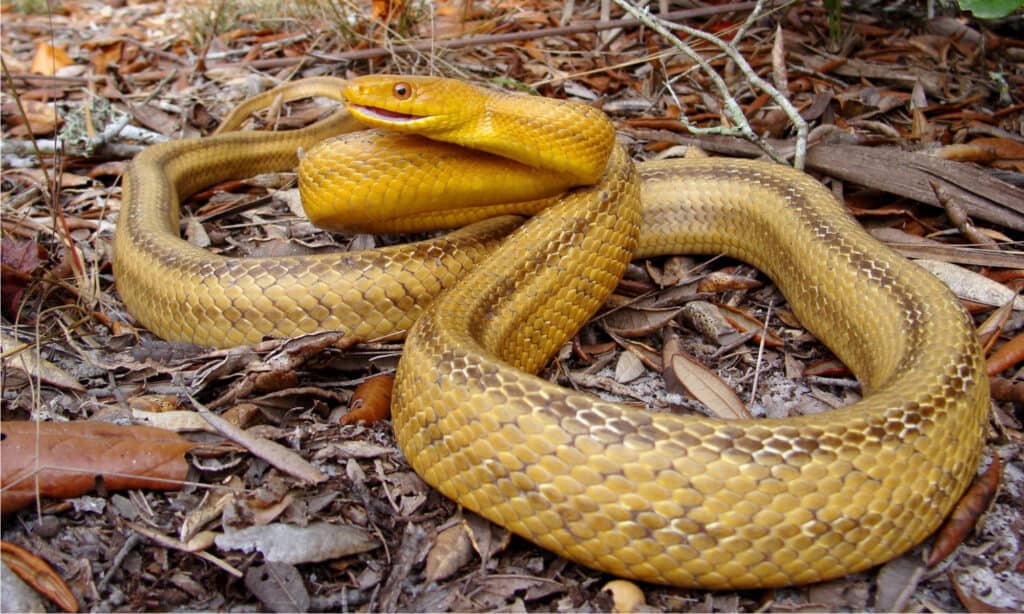
Eastern rat snakes are also known as yellow rat snakes.
©Matt Jeppson/Shutterstock.com
Although they are also known as yellow rat snakes, eastern rat snakes are typically yellowish orange or yellow with four darker stripes down their bodies. Eastern rat snakes are 36 to 72 inches long and are found east of the Apalachicola River and as far south as Key Largo. They prefer hardwood forests, farmland, and swamps, and some even live in urban areas. However, they hibernate underground during the winter months. Eastern rat snakes are not venomous and usually flee when threatened. If they are cornered then they vibrate the tip of their tail which creates a buzzing sound against the ground. Eastern rat snakes feed on birds, frogs, rodents, and lizards.
Plain-Bellied Watersnake
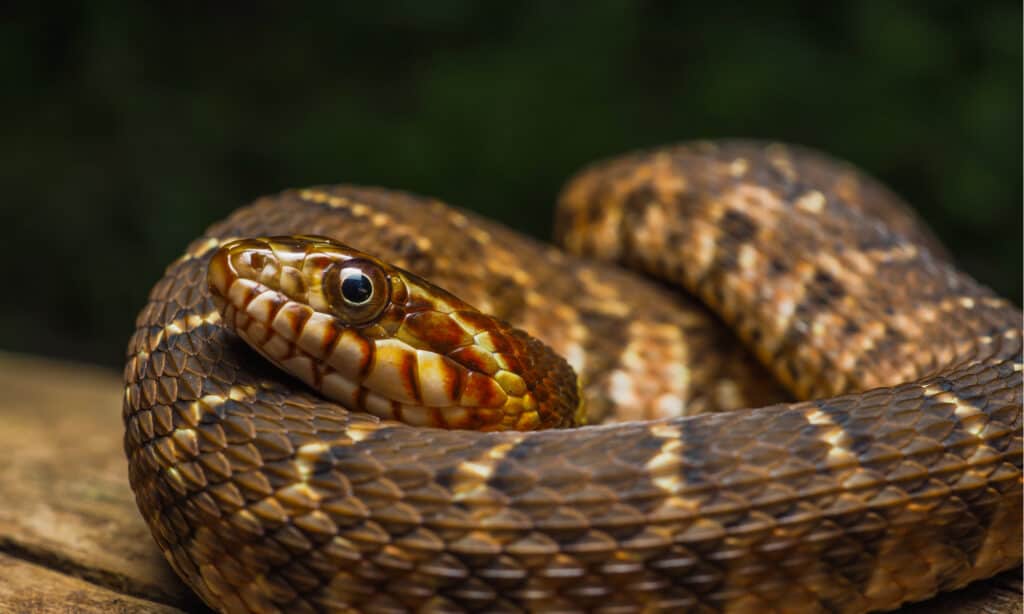
Despite their darker upper side, plain-bellied water snakes have much lighter bellies
©Tyler Albertson/Shutterstock.com
Named due to the lack of markings on their underside, plain-bellied watersnakes are a uniform color of reddish-orange to yellow on their bellies, necks, and lips. However, they are reddish-brown, olive green, or gray on their upper sides. Plain-bellied watersnakes are 24 to 40 inches long and are always found near a permanent water source. Their favorite habitats are lakes, rivers, floodplains, and swamps. Plain-bellied watersnakes are most active during the warm summer months when they spend their time either swimming or basking on logs or rocks. During the winter they hibernate underground or underneath rocks. Plain-bellied watersnakes eat mainly fish, frogs, and salamanders. They often wait patiently in the water for their prey to approach them rather than actively hunting.
Eastern Hog-Nosed Snake
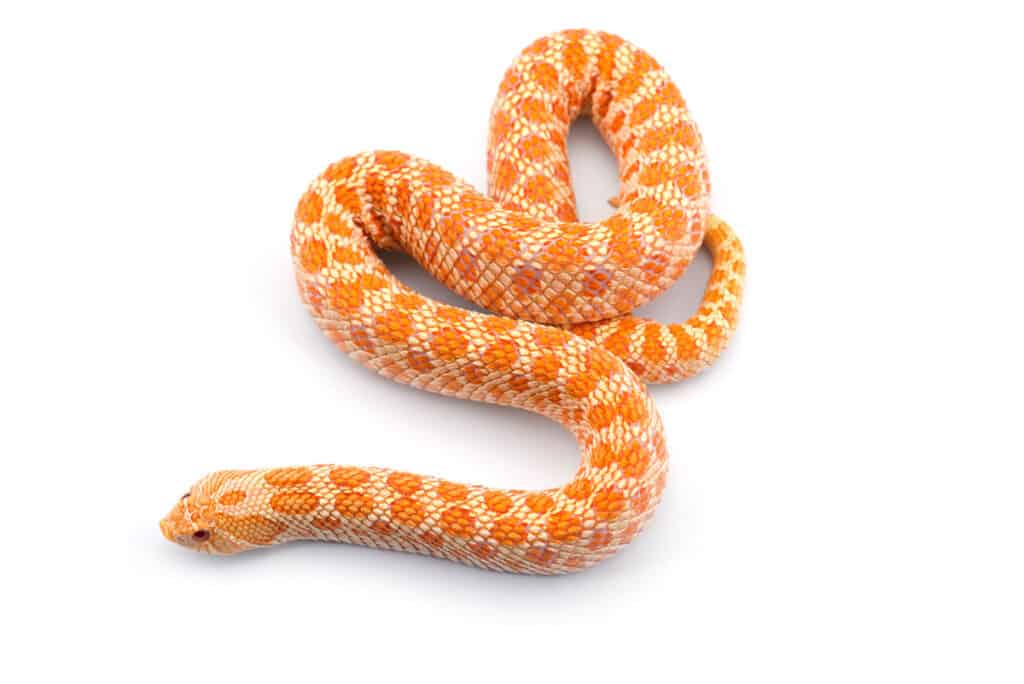
The color of eastern hog-nosed snakes can be orange, yellow, red, brown, or black, although in Florida orange and yellow is more common.
©PetlinDmitry/Shutterstock.com
An unusual orange snake in Florida is the eastern hog-nosed snake whose color and patterns vary widely, depending on their location. The color of eastern hog-nosed snakes can be orange, yellow, red, brown, or black, although in Florida orange and yellow is more common. Most also have many irregular shaped blotches which are a darker color – usually brown or black. Eastern hog-nosed snakes are usually 20 to 33 inches long and prefer pine forests and forest edges which have sandy soil. The loose soil is used for burrowing and egg-laying. Eastern hog-nosed snakes are mildly venomous but not harmful to humans. This is because they don’t produce true venom. Instead they produce a milder substance from their Duvernoy’s gland which they use to subdue their prey with (mainly toads). This is injected through their enlarged rear fangs.
Corn Snake
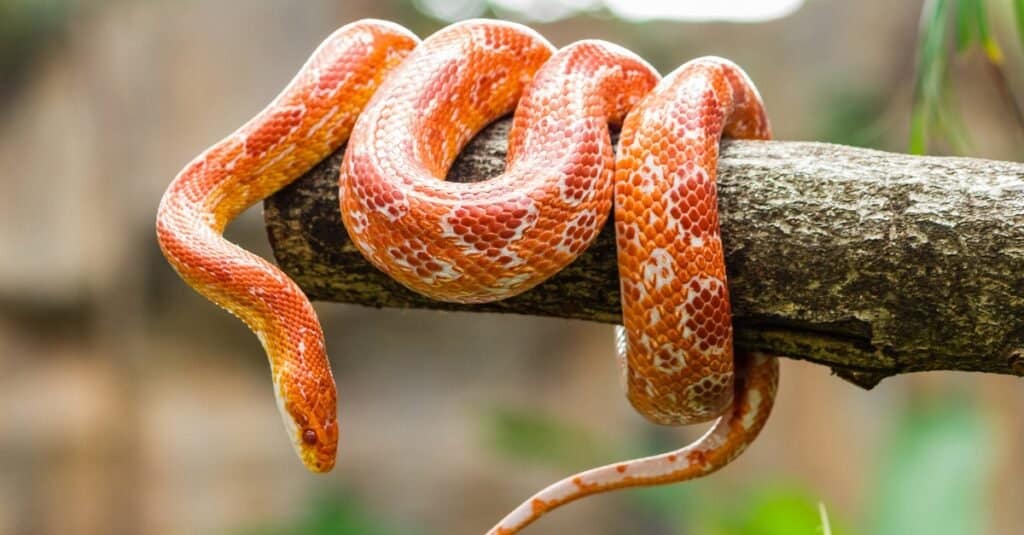
Corn snakes are bright orange with red blotches on them
©iStock.com/bugphai
One of the most popular snakes is the corn snake which is often kept as a pet. Corn snakes are 30 to 48 inches long and typically have orange or orange-brown bodies with large red blotches on them. They have a strong resemblance to copperheads which are venomous, which often results in them being killed due to misidentification. They are adaptable snakes but prefer habitats such as fields, forest openings, and farms. Corn snakes are also excellent climbers and are often found in trees. Corn snakes lay their eggs in warm, hidden locations, after which the female completely abandons them. The main diet of corn snakes is rats and mice and they are actually very beneficial as they keep rodent populations under control.
Ring-Necked Snake
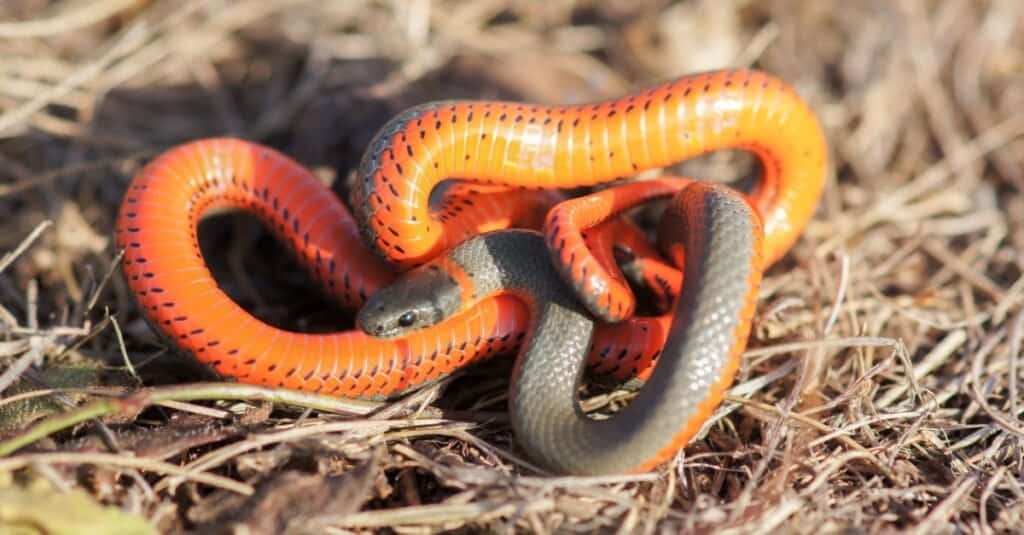
Small and colorful, the ring-necked snake is nocturnal and non-venomous.
©yhelfman/Shutterstock.com
Some of the most stunning snakes in Florida are ring-necked snakes which are named for the bright ring of color around their neck. Ring-necked snakes are black on their dorsal side but their bellies are either red, yellowish orange, or even red at one end and fading to orange and yellow at the other. Ring-necked snakes are adaptable and capable of living in a variety of different habitats. However, they prefer areas with plenty of vegetation for them to hide under – such as woodlands or hillsides. When threatened, ring-necked snakes coil their tail tightly and lift them off the ground to show their bright-colored belly as a warning. Ring-necked snakes are mainly nocturnal, although some are crepuscular, and they mainly eat slugs, earthworms, and salamanders.
Pine Woods Snake

Found across most of the Florida peninsula but not in the Florida Keys, the pine woods snake is nocturnal.
©Andrew Jeffries/Shutterstock.com
One of the smallest orange snakes in Florida is the pine woods snake which only reaches 10 to 13 inches long. Pine woods snakes are reddish-orange to reddish brown color with a lighter stripe down the center of their back. They are found across most of the Florida peninsula but not in the Florida Keys. Pine woods snakes prefer to live in areas with plenty of leaf litter, such as pine forests and damp woodlands. They are nocturnal snakes and feed mainly on lizards, frogs, and salamanders. Their predators include southern black racers and kingsnakes, as well as birds and shrews.
Red-Bellied Snake
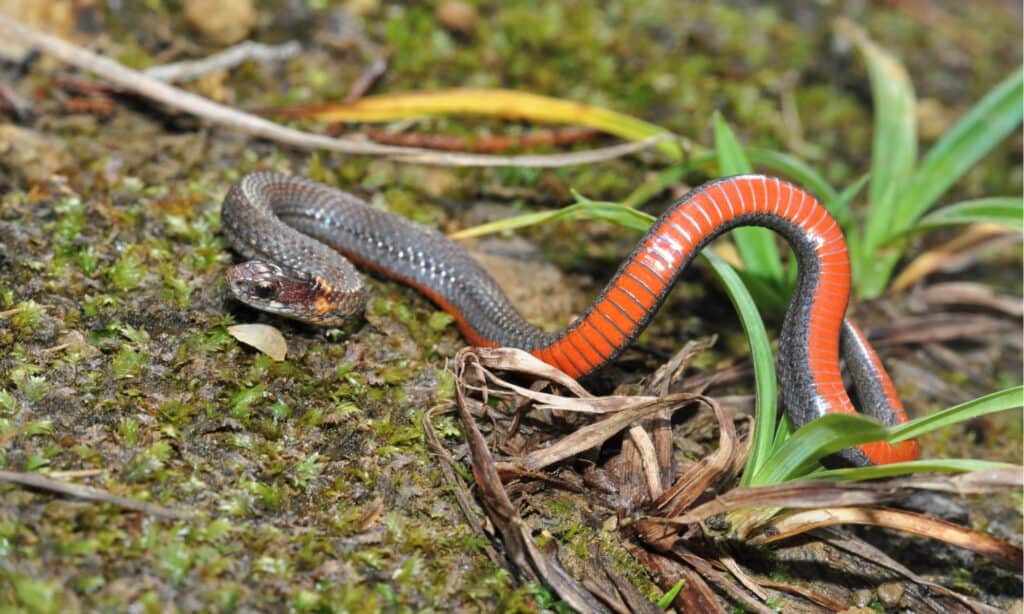
Red-Bellied snakes are brown on the top and various shades of red, orange, or yellow on their underside.
©Mike Wilhelm/Shutterstock.com
Another small snake is the red-bellied snake which is only 8 to 10 inches long. Although their name suggests that they have a red belly, they often have a bright orange or even a yellow belly. Dorsally they are reddish brown with faint stripes down their backs, while their heads are black or dark brown. Red-bellied snakes are extremely adaptable and live in many habitats, although they prefer areas with plenty of leaves, rocks, or logs for them to shelter underneath. Red-bellied snakes are nocturnal and their main diet is slugs and earthworms. They are not venomous and are not aggressive.
Salt Marsh Snake
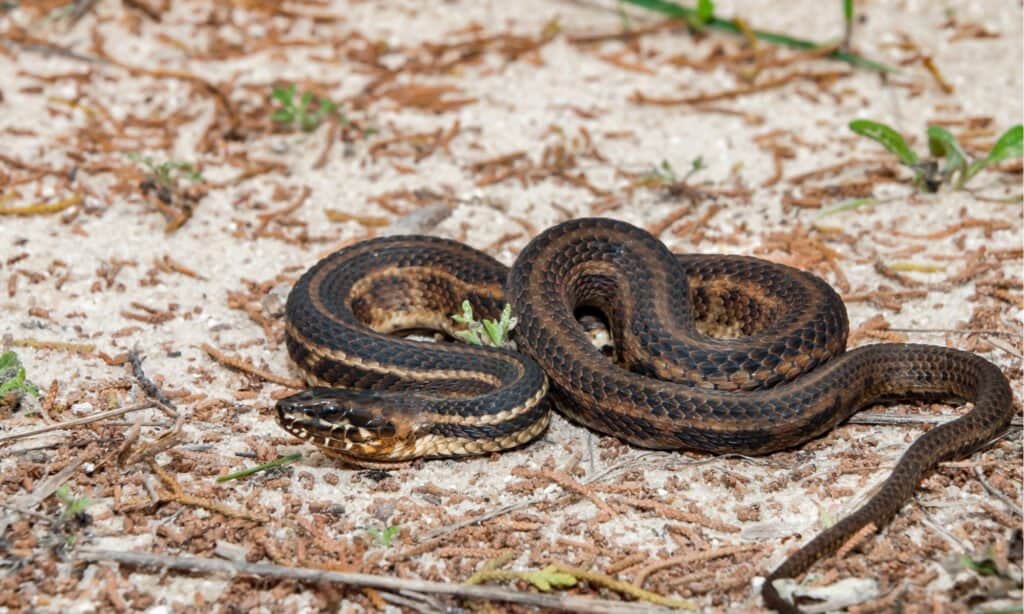
The salt marsh watersnake can be found along the coast of Florida in habitats with brackish water.
©Jay Ondreicka/Shutterstock.com
The final orange snake in Florida on the list is the salt marsh snake. Salt marsh snakes are usually a rusty orange or brown color with four darker stripes down their bodies. However, one subspecies – known as mangrove salt marsh snakes – which occurs in Florida from Tampa Bay down to Miami, is often completely reddish orange. Another subspecies – the Atlantic salt marsh snake – is classed as being under threat. Salt marsh snakes live in tidal marshes, mud flats, mangroves, and along the shoreline where they burrow into the mud and sand. They are nocturnal snakes and mainly eat small fish which are caught and eaten in shallow water. Predators include crabs and birds such as herons.
Summary Of 8 Orange Snakes In Florida
| Rank | Orange Snakes in Florida |
|---|---|
| 1 | Eastern Rat Snake |
| 2 | Plain-Bellied Watersnake |
| 3 | Eastern Hog-Nosed Snake |
| 4 | Corn Snake |
| 5 | Ring-Necked Snake |
| 6 | Pine Woods Snake |
| 7 | Red-Bellied Snake |
| 8 | Salt Marsh Snake |
Other Snakes Found in Florida

The Eastern Copperhead is one of the most notorious snakes in Florida.
©Dennis W Donohue/Shutterstock.com
The slithering serpents we discussed above are far from the only standout specimens from the Sunshine State. Many others are notable for their brilliant and beautiful colors, such as the Brahminy Blind Snake which is a gorgeous shade of periwinkle, while some get their reputation from being particularly dangerous, like the fearsome Eastern Copperhead which possesses a deadly venom.
Which State Is the Most Snake-Infested in the U.S.?

You probably won’t be very surprised to learn that Florida ranks in the top 10 most snake-infested states in the U.S. But where it ranks depends on how many snake species you count. While there are technically over 50 snake species living in Florida, not all of them are native species. According to the Florida Fish and Wildlife Conservation Commission (FWC), there are 44 native snake species in Florida. The rest are invasive species, many inhabiting the swampland of the Florida Keys. If we go with the 44 native species only, Florida ranks 9th for the most snake species in the country.
What state ranks first? That would be Texas, with a whopping 68 snake species! Venomous snakes in the state are several rattlesnake species, copperheads, cottonmouths, and Texas coral snakes. Nonvenomous snakes include the Texas indigo, Texas brown snake, Texas blind snake, and one of the most numerous–the Texas rat snake. The greatest concentration of snakes is in central Texas.
The top 10 most snake-infested states are as follows:
- Texas–68 species
- Arizona–52 species
- Nevada–52 species
- Louisiana–48 species
- Missouri–47 species
- New Mexico–46 species
- Oklahoma–46 species
- Georgia–46 species
- Florida–44 species
- Alabama–43 species
The photo featured at the top of this post is © Andrew Jeffries/Shutterstock.com
Discover the "Monster" Snake 5X Bigger than an Anaconda
Every day A-Z Animals sends out some of the most incredible facts in the world from our free newsletter. Want to discover the 10 most beautiful snakes in the world, a "snake island" where you're never more than 3 feet from danger, or a "monster" snake 5X larger than an anaconda? Then sign up right now and you'll start receiving our daily newsletter absolutely free.
Thank you for reading! Have some feedback for us? Contact the AZ Animals editorial team.






